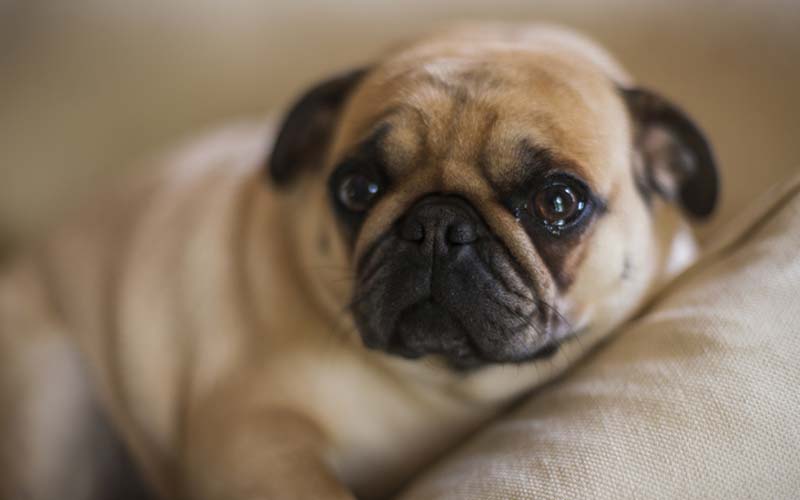Bringing home a new puppy is an exciting and joyful experience, but it can also come with challenges—especially when it comes to dealing with crying. Whether it’s whimpering at night, whining during the day, or constant vocalizations due to separation anxiety, a crying puppy can be stressful for both the pet and the owner. Understanding why puppies cry and learning how to calm them effectively is crucial for creating a peaceful and nurturing environment.

In this article, we’ll explore the common reasons puppies cry and provide practical, actionable tips to soothe your new companion. From setting up a cozy, safe space to establishing a comforting routine, you’ll find the solutions you need to ease your puppy’s anxiety and ensure a smoother transition into your home. With the right approach, calming your puppy can be simple, ensuring that both you and your puppy enjoy this early bonding phase.
1. Understanding Why Puppies Cry
Puppies cry for a variety of reasons, many of which are rooted in the natural anxieties and adjustments they face in their early days. Recognizing the cause behind the crying is the first step toward calming your new companion.
Separation Anxiety
One of the most common reasons puppies cry is separation anxiety, especially in the first few days or weeks after leaving their mother and littermates. This sudden change can leave a puppy feeling lonely and anxious. Puppies are pack animals by nature, and when left alone, they may cry as a way of calling out for comfort and companionship. It’s important to ease this transition by gradually getting them used to spending time alone and creating a secure, comforting space for them.
Basic Needs
Whining often occurs when a puppy’s basic needs aren’t met. Hunger, thirst, or the need to relieve themselves can prompt crying, especially if they haven’t yet adjusted to a regular routine. Ensuring that your puppy is well-fed, hydrated, and has frequent bathroom breaks is essential to minimizing their discomfort and the likelihood of crying.
Fear of New Surroundings
Puppies are sensitive to new environments, and unfamiliar sights, sounds, and smells can overwhelm them. A loud noise, sudden movement, or an unfamiliar object may trigger fear, leading to crying. Providing a quiet, secure space where the puppy can gradually adjust to their new home can help reduce this anxiety.
Discomfort or Illness
Excessive crying may also signal physical discomfort or illness. If your puppy continues to cry despite all efforts to soothe them, it may be a sign of an underlying health issue, such as pain or digestive problems. In such cases, a visit to the veterinarian is crucial to rule out any medical concerns.

2. Setting the Right Environment for a Calm Puppy
Creating a comfortable and secure environment is essential for calming a crying puppy. By preparing a space that meets their physical and emotional needs, you can significantly reduce anxiety and help them settle into their new home more easily.
Creating a Safe and Cozy Space
Puppies are comforted by familiar smells and warmth. Preparing a soft, cozy bed with blankets that carry your scent or even the scent of their littermates can help ease their separation anxiety. Adding soft toys that mimic the warmth and feel of their litter can provide an extra layer of comfort. Ensure the sleeping area is in a quiet, draft-free spot to help the puppy feel safe. The goal is to create a space that feels like a secure retreat where they can rest and relax.
Establishing a Routine
Puppies thrive on routine, and setting a consistent schedule for feeding, bathroom breaks, and sleep is key to helping them feel secure. Regular meal times and frequent bathroom breaks reduce uncertainty and help prevent crying caused by hunger or discomfort. A consistent bedtime helps the puppy develop healthy sleep habits and signals that it’s time to settle down. Over time, the routine will provide a sense of predictability, reducing anxiety and promoting a calm demeanor.
Crate Training Basics
A crate, when used correctly, can be a powerful tool in providing a comforting, den-like environment for your puppy. It gives them a safe, enclosed space where they can rest without being overwhelmed by the rest of the home. To make crate training positive, ensure the crate is properly sized—not too big or too small—and introduce it gradually, associating it with good experiences like treats and toys. The crate should never be used as a punishment; instead, it should be a place where your puppy feels secure and can retreat when they need quiet time.
By creating the right environment and establishing a steady routine, you’ll help your puppy feel more at ease, which can significantly reduce the frequency and intensity of their crying.

3. Techniques to Calm a Crying Puppy
Calming a crying puppy often involves using gentle, thoughtful methods that address their needs for reassurance and comfort while encouraging gradual independence. Here are a few effective techniques that can help soothe your puppy and reduce their crying over time.
Gentle Reassurance
A crying puppy often needs to be reassured that they are safe. Speaking calmly in a soft voice or gently stroking your puppy can help soothe their anxiety. It’s important to offer this comfort without overdoing it—too much attention, especially in response to every cry, can unintentionally reinforce the behavior, making them cry more in hopes of getting more attention. The key is to offer reassurance in moderation, so the puppy feels secure but doesn’t become dependent on constant petting.
Gradual Comfort and Separation
Many puppies cry due to separation anxiety, so it’s important to teach them how to be alone without fear. Start by leaving your puppy for short periods and gradually increase the duration of time they spend alone. Leaving comforting items, such as a blanket that smells like you or their littermates, can help ease this transition. Gradual desensitization to being alone helps reduce dependence on constant attention, making them less likely to cry when you’re not around.
White Noise and Calming Aids
Some puppies respond well to calming aids like white noise machines or toys that simulate a heartbeat, mimicking the sounds and sensations they felt when with their mother. These tools can help drown out unfamiliar household noises and provide a soothing, rhythmic background that encourages rest. Additionally, using calming scents like lavender in their sleeping area may also help create a peaceful atmosphere, reducing anxiety and crying.
Exercise and Stimulation
A well-exercised puppy is more likely to be calm and rest quietly. Regular playtime and physical activity tire them out, making it easier for them to settle down and sleep. Mental stimulation, such as puzzle toys or basic training exercises, also helps tire out their mind, reducing boredom-induced crying. Ensuring your puppy has both physical and mental outlets will keep them happier and less prone to whining out of frustration or restlessness.
By using these techniques, you can effectively calm your puppy while promoting healthy emotional development. Consistency and patience are key to gradually reducing crying and helping your puppy feel secure.

4. Avoid Common Mistakes
While it’s natural to want to soothe a crying puppy immediately, certain approaches can inadvertently reinforce the behavior or create long-term challenges. Avoiding these common mistakes will help you establish healthy habits early on.
Don’t Reward Crying
It’s important not to respond to every cry your puppy makes. Rushing to comfort them every time they whine can reinforce the idea that crying gets attention, leading to more frequent whining. Instead, wait for a pause in the crying before offering comfort or attention. This teaches your puppy that being calm, not crying, earns your response. By waiting for the right moment, you help your puppy learn to settle themselves over time.
Avoid Overfeeding for Comfort
Using food to calm a crying puppy can lead to unhealthy habits. While treats can be useful for training, feeding your puppy every time they cry can lead to overeating and weight issues. It also creates a cycle where the puppy associates crying with receiving food, making it harder to break the habit. Instead, focus on using comfort items like toys or a soothing voice to calm your puppy without relying on food.
Don’t Skip Crate Training
Crate training is an effective way to provide your puppy with a safe and secure space, even though it may feel difficult at first. Some owners may feel guilty about using a crate, but when done correctly, it creates a den-like environment where your puppy can feel protected. Avoid skipping this step due to initial resistance. Instead, make the crate inviting with comfortable bedding and positive reinforcement like treats or toys. Over time, your puppy will see the crate as a place of comfort rather than confinement.
By steering clear of these common mistakes, you’ll help your puppy develop healthy, long-term habits and create a calmer, more secure environment.

5. Knowing When to Seek Professional Help
Even with the best efforts to soothe a crying puppy, there may be times when professional intervention is necessary. Recognizing when to seek help can prevent further distress for both you and your puppy.
Persistent Crying or Signs of Illness
If your puppy continues to cry despite trying various calming techniques, it could indicate an underlying issue that requires medical attention. Persistent crying, especially if accompanied by other signs such as lethargy, vomiting, diarrhea, or changes in appetite, may signal health problems that need a veterinarian’s assessment. It’s crucial to monitor your puppy for these symptoms and consult a vet if you notice anything unusual. Early intervention can address potential health issues before they become serious.
Working with a Trainer or Behaviorist
For puppies exhibiting extreme separation anxiety or persistent nighttime crying that doesn’t improve with home techniques, consulting a professional dog trainer or behaviorist can be beneficial. These experts can provide tailored strategies and training methods to address specific behavioral challenges. They offer valuable insights into advanced techniques for managing anxiety and can help establish effective routines and coping strategies. Professional guidance ensures that you’re addressing the root of the issue effectively and providing your puppy with the best possible support.
Recognizing the signs that require professional help will ensure that your puppy receives the care they need and that you have the support to navigate any ongoing issues effectively.

Conclusion
Caring for a new puppy can be both rewarding and challenging, especially when faced with the task of calming a crying pup. By understanding the common reasons behind a puppy’s cries and implementing effective calming techniques, you can create a nurturing environment that helps your new companion feel secure and at ease.
To recap, start by identifying why your puppy is crying—whether due to separation anxiety, unmet basic needs, fear of new surroundings, or potential discomfort. Set up a comfortable and safe space, establish a consistent routine, and employ calming techniques such as gentle reassurance, gradual comfort, and appropriate aids like white noise machines or calming toys. Avoid common pitfalls such as rewarding crying with constant attention or overfeeding and ensure you don’t skip essential practices like crate training.
If you encounter persistent issues or notice signs of illness, don’t hesitate to seek professional help. Consulting a veterinarian or a qualified trainer can provide valuable assistance and ensure your puppy’s well-being.
Remember, patience and consistency are key. By following these strategies, you’ll not only help your puppy adjust more smoothly but also foster a strong bond built on trust and security. Take action today to implement these solutions and enjoy a calmer, happier experience with your new furry friend.